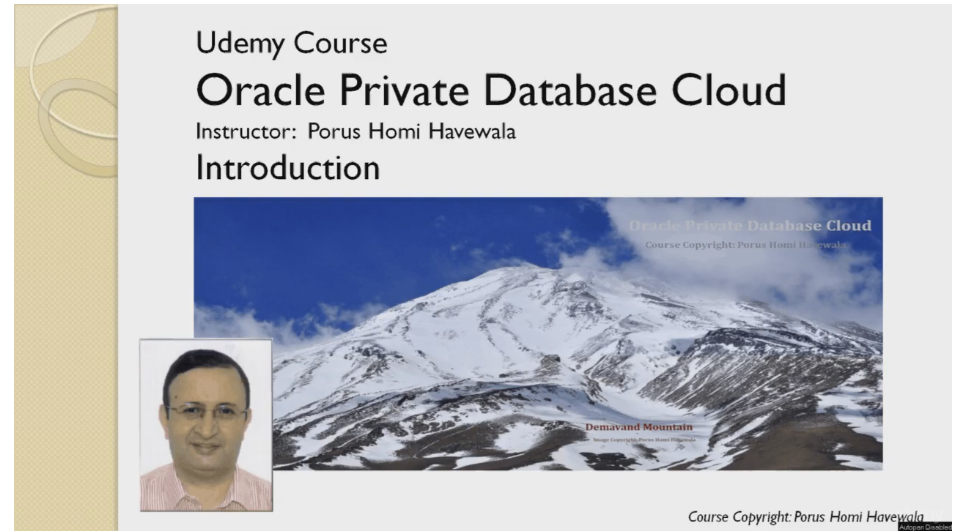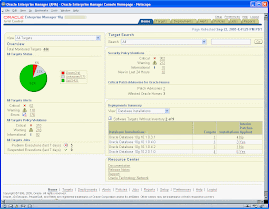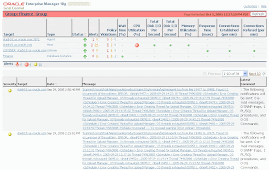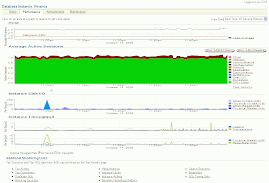Monday, May 26, 2008
Grid Control Architecture Podcast
Friday, May 23, 2008
Oracle got it right when it moved Enterprise Manager to the current web-based OC4J (Oracle container for Java) and Application server based architecture, which is inherently much more scalable (more on that later). The EM management server is a cut-down version of Oracle Application server in that respect.
You said "I feel very relieved today to have EM for DBA work that can be accessed using a browser only." You are right. Some Dbas who say they are traditional Dbas frequently look down on EM, but the question is how long they can afford to do so, and is it wise to do so? Oracle database facilities are becoming more and more sophisticated. For eg. sure you can create 10g tuning sets in the command line, and run the tuning advisor, and other 10g performance things, but you have to issue an awful lot of complicated commands. Why do that when you can simply and easily use Grid Control? Find the busiest period on your database, drill down to the top statements during that period, select them and create a tuning set, then run the tuning advisor. It is that simple and cuts down on the manual time of typing all those commands.
Also Oracle strongly recommends the use of Grid Control for managing sophisticated systems like RAC, especially for performance. Sure you can have RAC and manage RAC without Grid Control, but would you drive a Ferarri with bullock cart reins? Would you run RAC with just SqlPlus? (I do apologize to the writers of SqlPlus for comparing SqlPlus to bullock cart reins, but that is how we see it, as compared to powerful tools like Grid Control). Management also should be convinced that when they go in for RAC, they should have it managed by Grid Control.
As consultants we frequently strongly recommend this to management of any company who wants to use RAC.
Your analysis of the benefits of using Grid Control over Database control is also spot on. With Grid Control you can manage multiple databases, set up RMAN backups, see all RMAN backup jobs, set up Dataguard, monitor Dataguard and so on, just as you have pointed out.
Thanks Santosh for your excellent feedback on the advantages of Grid Control.
Do keep writing to this blog.
Thursday, May 22, 2008
EM Grid Controls Advantages
I am using Oracle DB since last 7 years and have worked on versions 7.3, 8iR3, 9iR2 and 10gR2. With every new version the Tools to do DBA work got very much improved.
With no tool in 7.3 to EM Dbcontrol in 10g. When I look back and think how I do DBA activity in 7.3 I feel very relieved today to have EM for DBA work that can be
accessed using a browser only.
But again when I got introduced with 10g DB, I selected DB control over Grid Control,
thinking why to install agent software additional when I have already installed DB
control which got installed with Oracle DB Software! But my decision was wrong. I soon come to realize the power of Grid Control.
We have multiple databases for different purpose. With DB Control, I could manage
all the databases but at what cost?
I have to start DB console of every DB, plus each individual em process consumed
a lot of CPU resource, plus I also have Oracle AS, a separate em of it also. I
really have to consume a lot of memory (of server and myself ). Then I
implemented RMAN backups for all of our DBs. I did it using DB control, but our backup policy was such that I have to schedule backups as per weekdays (eg.
incremental level 0 backup on every Monday, Wednesday,Friday), this I could not
do using DB control, hence I have to write backup script and schedule it from OS
crontab. Then I have to implement Standby Databases and Dataguard for some of
the databases. For 1st DB I did it manually. Oh, my god, It was really a test of your
patience. Anyway I finished it successfully but I could not forget the stress while
doing it. Then It was the time when Oracle consultant (Mr. Porus, one of the author on this blog) suggested to use Grid control.
I implemented it with help of him. After that I did implementation of all the standby
DB creation and Dataguard activity with the help of Grid control. It was very easy
to do the things with Grid, plus the system resources ware used better. With Grid then
I scheduled RMAN backups as per our policy (schedule on weekdays) and I can
also manage AS with it.
I can summarize like this:
1] Dataguard and Scheduleing RMAN backup on weekdays (like crontab in Unix) can
be done with the help of Grid control.
2] No need to start individual DB Controls for DBs and iascontrols for ASs.
3] Can save resources of your system.
4] Many additional features for Administering the DBs and App. Servers.
Sunday, May 18, 2008
Please vote in the survey
put up on this blog ie.
"The best way you have used Grid Control so far is:"
I have put a number of interesting options.
Let me know ideas for other surveys as well.
Invited people to write
to write to the blog, especially those who have used Grid Control in some
form or the other.
If any of the numerous Blog readers from the internet also want to become
authors of this site, do add a comment to any of the articles and mention
you want to be an author to this blog, and I will send you an invite.
Once you are an author, you can send an email about Grid Control
directly from your gmail accouunt. Just send your email to :
<<your gmail login>.enterprise-manager@blogger.com>,
It will be published immediately on the Enterprise Manager blog.
Friday, May 16, 2008
The power of EM
"Steps to Fusion - Centralize the Management of Your Applications on
Oracle Enterprise Manager"
http://appmanagementblog.blogspot.com/2008/05/step-to-fusion-centralize-management-of.html
More Reasons to use Em10g
We are planning an OEM deployment to make use of Grid Control across the company...Our plan is to have a single OEM "view" of the company for all Oracle DBAs and will include global server load balancing using Big-IP...
The main reasons for the OEM build are :
1) Provide the DBAs with a single view of the Oracle estate along with
instance management improvements;
2) Provide a management interface for the planned RAC build.
I wrote back:
Your reasons for deploying EM10g are excellent, may I add another reason, to provide senior Management with a view of Oracle licences across the organization, and more importantly, the use or non-use of expensive allocated San storage space. This was a very important reason in a large telecom whereby management was able to save more than a million dollars each year. The telecom had asked Oracle to write a special disk storage usage report. Oracle has since incorporated the report in Release 2 of EM10g so it comes along with the product along with many other reports.
Regards,
Porus.
RMAN and Enterprise Manager
schedule daily maintainance tasks, such as RMAN backups. RMAN is
one of the best utilities from Oracle to back up your databases, and it
amazes me that there are some people out there still doing cold backups.
This is one of the oldest techniques of backup, when it was not possible
to do any online (hot) backups, people were forced to do offline (cold)
backups. But when Oracle created online backups (with the alter
tablespace ... backup command), when Oracle created the RMAN
backup utility, then who would still use offline backups?
In any case, coming back to the point, RMAN backups can be set up
very easily using Grid Control. In the past, we used to write unix scripts
to call RMAN, then these scripts had to be installed on each new database
server with modifications, then tested. This normally took about 4 hours
or so for each new database server. But when the same is done using
Grid Control, all we need is the Enterprise Manager Agent on each
server, then we can easily configure and set up and schedule the
RMAN backup for the databases on that server. It would take no
more than 10 minutes or so to do so, which is a big saving in time,
besides the fact that no unix scripts or cron jobs at the unix level
are involved. Grid Control generates the scripts and schedules
the scripts at the times you want, and all logs are accessible
at the Grid Control level.
More on this later. Right now I want to mention my OTN article
"Technical Note: Using Oracle Grid Control with Filer Snapshotting"
which you can read at
http://www.oracle.com/technology/pub/notes/technote-oem-filer.html ,
this explains how you can use Grid Control with Netapps
Filer snapshots to backup the database.
Regards,
Porus.
Thursday, May 15, 2008
Introduction and First Post
I am a Senior Oracle DBA / Database Consultant with broad experience in Oracle technology since 1994 including 7+ years as a Production Dba, 7 years as a Senior Database Consultant, 2.5 years as an Oracle E-Business Technical Dba and Systems Administrator, and approx. 6 years as a Development Dba / Database Designer Modeller (yes, using Oracle Designer).
I am also an Oracle ACE (for those who are not aware, this is an award from Oracle Corporation).
I started using Oracle Enterprise Manager right from the days of Server Manager. Well, used it as far as it was possible in those days, but I was always interested in Gui management of the database. I have seen Enterprise Manager become more and more better over the years, until finally, when Oracle released Enterprise Manager 10g Grid Control and Database control in the early 2000s, it was good enough to deploy at the Enterprise level. At Telstra in Australia, we did just that, we had a central EM10g installation with three load balanced management servers, and this was being used to manage literally 100s of databases and servers (more than 700) all around Australia and managed by tens of database teams.
We were the first in the world to put Grid Control in production. I was also a Beta tester of EM10g Grid Control Release 2 when it came out. I have been an enthusiast of Grid Control ever since, because I discovered it really delivered the goods, in day to day administration, in things like RMAN backups and Dataguard setup and monitoring.
When I was employed at Oracle India, I convinced a number of banks and a large telecom in India to use Grid Control, and they started to use it very effectively.
I thought of setting up this blog so that people can discuss the use of Grid Control. Please go ahead and post,
Regards,
Porus Homi Havewala.
Disclaimer
Blog Archive
-
▼
2008
(49)
-
▼
May
(10)
- Grid Control Architecture Podcast
- I was searching for blogs on Grid Control in Googl...
- Santosh, you are quite right, Oracle has definitel...
- EM Grid Controls Advantages
- Please vote in the survey
- Invited people to write
- The power of EM
- More Reasons to use Em10g
- RMAN and Enterprise Manager
- Introduction and First Post
-
▼
May
(10)
Labels
- Advantages and Power
- Interesting
- General Discussion
- technical
- 11g
- grid control
- New in 11g
- Grid Architecture
- article
- News
- Patching
- free
- new in 12c
- em12c cloud control
- workshop
- Packs and Plug-Ins
- book
- 11g book
- issue resolution
- webinar
- white paper
- RMAN and Grid
- charity
- cloud control
- webcast
- Greetings
- em11g
- GoldenGate
- event
- exadata
- ops center
- security grid control
- 12c book
- Launch
- OTN
- POC
- published
- seminar
- Linux and Grid Control
- PeopleSoft
- answers
- artcile
- automation
- em jobs
- list
- live chat
- migration
- overview
- presentation
- questions
- testing
- video
Other Interesting Oracle Blogs
-
-
-
-
Upcoming Events...10 years ago
-
-













